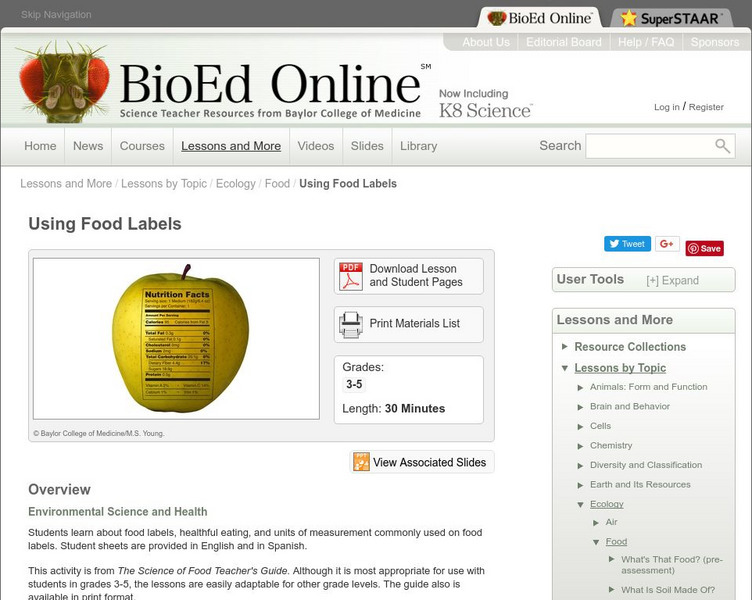Hi, what do you want to do?
Curated OER
Microwave Introduction
Sixth graders learn the principles of microwave cooking and how to use and care for it properly while preparing foods.
Curated OER
Counting on Good Health
First graders engage in fun activities in order to understand the food pyramid and how to make healthy nutritional choices. The lesson is used in order to help students make healthy lifestyle choices.
Curated OER
What's in a Willow?
Students study of nutritional value of edible native plants. discriminate between foods that have nutritional value and those that do not. They relate how food can affect how they think, feel, and perform.
Curated OER
Life Science: Heavy Weight
High schoolers investigate adolescent obesity and its health impact. In this health and obesity lesson, students research the problem, develop a survey regarding eating habits, then analyze the nutritional information on commonly eaten...
Curated OER
Yeasts and Molds
Students investigate the characteristics and nature of yeast and molds help to explain how these microorganisms affect food production. They experiment with yeast in sourdough in preparing sourdough pancakes.
Curated OER
Yo! Gert-making yogurt
Young scientists or chefs culture yeast to produce yogurt. The materials and a general description of how make yogurt are provided, but there is very little detail otherwise. You could use this as an activity when your biology class is...
Curated OER
Exploding Cheeseburgers
Young scholars identify the components of a healthy diet. In this nutrition lesson, students discuss the parts of a cheeseburger and identify the food groups the cheeseburger is a part of. Young scholars discuss how carbohydrates and...
Curated OER
Microwave Cooking
Students learn the basic principles of microwave cooking and prepare a dessert in the microwave using correct procedures.
Curated OER
Pre-K Appetizer: Lesson for Pre-Kindergarten
Students explore food choices by researching the food pyramid in class. In this healthy eating habits activity, students discuss each layer of the food pyramid and identify areas they need to improve in their own lives. Students visit...
Curated OER
Ground Beef Lab - Open-Faced Tacos
Students will use ingredients and read a recipe to create open faced tacos. The emphasis of the lesson is the kind of preparation that is needed to cook ground beef correctly to avoid diseases associated with improper preparation...
NC Cooperative Extension, Guilford County Center
Life Cycle Of Painted Lady Butterflies
The Very Hungry Caterpillar is the inspiration for this project-based learning activity. Kindergartners create a lifecycle chart for a butterfly with four sections: egg, caterpillar, pupa, and butterfly. It is a three-dimensional...
Curated OER
Quick Breads (Banana Muffins)
Students review what they know about quick breads and bananas. In this art lesson, students discover two different recipes for Banana Muffins off of the computer. Students prepare a recipe for Bananas Muffins carefully and clean up their...
Curated OER
Agriculture: It Doesn't Just Happen
After reading an informational text on the Agricultural Research Service, learners research the role of the ARS in Oklahoma. Using reputable online sources, they label a map of the state with relevant areas. Researchers focus on one of...
Curated OER
Dietician/Nutritionist
Explore the difference between a dietician and a nutritionist and then examine how these professionals serve the community. A PowerPoint presentation and accompanying worksheet are provided to teach this career exploration material. A...
Curated OER
Jr. Chef Club
Students review proper hand washing techniques and make a recipe. In this cooking lesson plan, students explore how to wash their hands properly before cooking and how to make a few edible treats.
Curated OER
The Big Apple
Young scholars study the buying and selling market and how prices are determined for an agricultural product. In this competitive market lesson plan, students study how prices are determined in a market by studying the forces of supply...
Curated OER
Agriculture - It Doesn't Just Happen
Sixth graders examine the role of the US Department of Agriculture. In this United States Agriculture lesson, 6th graders create maps with sites and specialty areas. Students create a presentation on the topic they were given to...
Curated OER
Alligator Craft Paper Bag Puppet
Students make paper bag puppets. They use the puppets as a story teller and reader. Students use the puppets to ask questions during and after reading. They assemble their own puppet. Students use the puppets to introduce new themes,...
Curated OER
World Hunger
Students research the causes and effects of world hunger on children. In this world hunger lesson, students discuss causes and effects of hunger around the world and research a specific area affected by hunger. Students prepare a...
Curated OER
Heat Transfer
The learners construct a heating curve and explain its components. They perform calculations. They review phase changes and quantify Energy differences. They review phases of matter and their energy content.
Curated OER
Healthy Living: How Does this Web Site Impact Medicare?
Learners assess information on the Health Canada Web site and determine whether such information should be paid for with tax dollars, and whether the publication of such information has an impact on Medicare.
Curated OER
Journal Prompts for November
In this journal prompts for November worksheet, students cut the cards (there are three on a page) then use one for each day in November as a prompt for journal writing.
Other
British Nutrition Foundation: Food a Fact of Life (11 14 Years)
A rich collection of eleven learning modules that cover a wide range of topics, including nutrition, diet and health, food science, agriculture, food preparation, food processing, food safety, and more. Modules have PowerPoints,...
BioEd Online
Bio Ed Online: Using Food Labels
Do you know how to read a food label? Food labels provide important information about the nutritional value of foods. In this lesson students will learn about food labels, healthful eating, nutrition facts, and units of measurement...




























